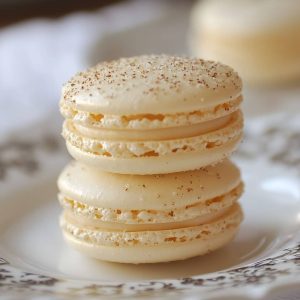
Vanilla Macaron Recipe
Vanilla macarons are delicate French cookies with crispy shells and a rich vanilla buttercream filling. With careful technique, these elegant treats can be easily mastered for any occasion.
Ingredients
- 170 grams almond flour
- 300 grams powdered sugar
- 180 grams egg whites at room temperature
- 160 grams granulated sugar
- 4 grams pure vanilla extract
- ½ batch Swiss meringue buttercream
Instructions
- Do not stir the meringue. It's okay to deflate some of the meringue at this stage, but not all of it.
- Add the remaining almond mixture to the meringue and gently fold them together. Deflate a bit more air in the batter by using the spatula to scrape the mixture against the bowl in a circular motion. Turn the bowl as you do this to evenly spread the batter around.
- Frequently test the mixture's consistency. The batter should flow like honey when you lift the spatula. You should be able to slowly trace a figure 8 with the batter without it breaking.
- Fit a piping bag with a round tip. Hold the piping bag at a 90˚ angle to your baking sheet and pipe the batter onto each traced circle. Squeeze the bag to fill each circle, then stop squeezing and give a little flick of the wrist to prevent the batter from forming a peak.
- Carefully tap the baking sheet on the counter a few times to remove any air bubbles and flatten any peaks. This will help the macarons spread slightly.
- Allow the macarons to sit at room temperature for 20-40 minutes, or until a skin forms on top (you should be able to touch them gently without your finger sticking).
- Bake for 15-20 minutes. Each macaron should have a foot that remains stable without browning. To test for doneness, gently press on the feet; they should not move.
- Remove from the oven and let them cool on the hot sheet pan for 10 minutes. Then, carefully peel each macaron off the parchment paper and let them cool completely on a wire rack.
- Fill a piping bag with the prepared Swiss meringue buttercream. Cut the tip off the piping bag and pipe a dime-sized amount of buttercream onto half of the macarons. Top with the remaining shells and gently press them together to evenly spread the filling. Enjoy!